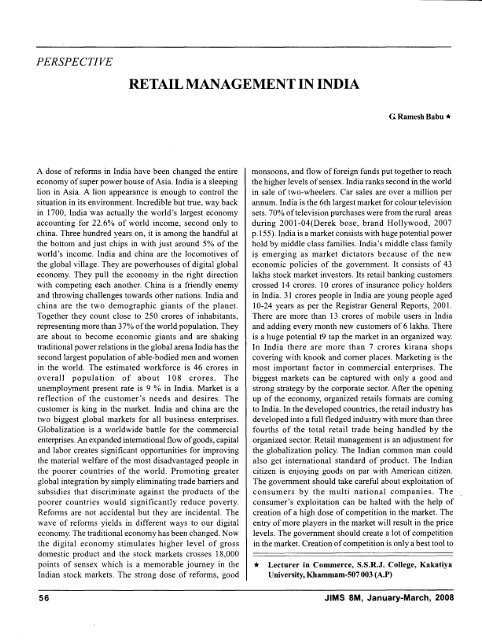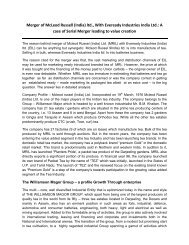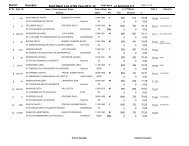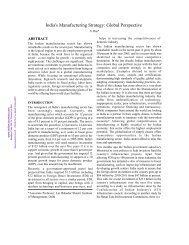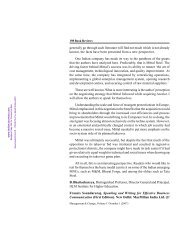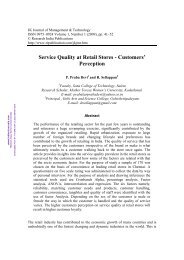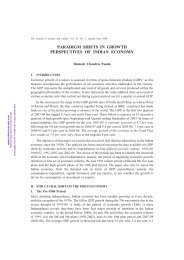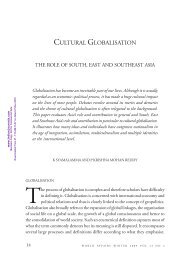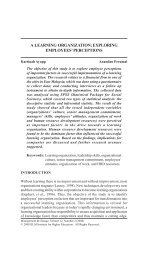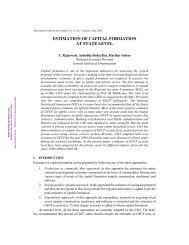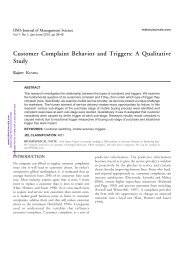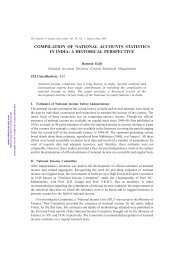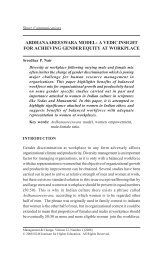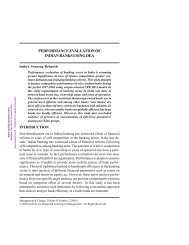Retail Management in India-23.pdf - Mimts.org
Retail Management in India-23.pdf - Mimts.org
Retail Management in India-23.pdf - Mimts.org
You also want an ePaper? Increase the reach of your titles
YUMPU automatically turns print PDFs into web optimized ePapers that Google loves.
suppress the consumer exploitation by the mult<strong>in</strong>ation<br />
companies. The share of <strong>org</strong>anized retail<strong>in</strong>g is less than<br />
I % <strong>in</strong> <strong>India</strong>, compared to 80% <strong>in</strong> USA, 40% <strong>in</strong> Thailand<br />
and 20% <strong>in</strong> ch<strong>in</strong>a. As per some estimates, there are over<br />
200 retail mall projects under construction or under active<br />
plann<strong>in</strong>g stage spann<strong>in</strong>g over 25 cities. The exist<strong>in</strong>g<br />
supply cha<strong>in</strong> <strong>in</strong> <strong>India</strong> for most goods is woefully<br />
<strong>in</strong>efficient, and built around obsolete warehous<strong>in</strong>g,<br />
logistics and transportation technology. Furthermore, the<br />
omnipresent middleman compounds this problem. <strong>India</strong><br />
was now part ofthe global economy and that the economy<br />
was rid<strong>in</strong>g on the back of middle class consumption.<br />
F<strong>in</strong>ally the impression was that large foreign companies<br />
were poised to <strong>in</strong>vest <strong>in</strong> large shopp<strong>in</strong>g centers as the<br />
<strong>India</strong>n market is now reputed to be the fastest grow<strong>in</strong>g<br />
retail market <strong>in</strong> the world. (Sridhar 2007). Accord<strong>in</strong>g to a<br />
survey by at Kearney, an overwhelm<strong>in</strong>g proportion of the<br />
Rs. 4, 00,000 crores <strong>India</strong>n retail market constitutes the<br />
un<strong>org</strong>anized sector. In fact only rs. 20,000 crores of<br />
segments ofthe market are <strong>org</strong>anized. <strong>India</strong> has been called<br />
a nation of shopkeepers due to the existence of a large<br />
number of enterprises <strong>in</strong> the country which totaled over<br />
12 million <strong>in</strong> 2003. About 78% of these are small family<br />
bus<strong>in</strong>ess utiliz<strong>in</strong>g only household labor. Even among retail<br />
enterprises that employ hired workers, the bulk of them<br />
use less than three workers. <strong>India</strong>'s first true shopp<strong>in</strong>g<br />
mall complete with food courts, recreation facilities, and<br />
large car park<strong>in</strong>g space called "Cross Roads" was<br />
<strong>in</strong>augurated <strong>in</strong> 1999 <strong>in</strong> Mumbai.The report <strong>in</strong> media<br />
<strong>in</strong>dicated that a tie-up between Walmart and Bharati<br />
Enterprises has been made and this venture is significant<br />
<strong>in</strong> the <strong>India</strong>n retail management market. As per their<br />
agreement, BHARATI will run the front end of the<br />
bus<strong>in</strong>ess and Wal-Mart the supply cha<strong>in</strong>. Reliance<br />
<strong>in</strong>dustry was also made collaboration with Brita<strong>in</strong>'s Tesco<br />
and France's Carfefour. It plans to <strong>in</strong>vest 5.6 billion dollars<br />
<strong>in</strong> 4,000 stores <strong>in</strong> 1,500 towns across <strong>India</strong>. As per<br />
the report of f<strong>in</strong>ancial express, dated 4-10-07, A V Birla<br />
has announced <strong>in</strong>vestment ofRs.8, 000 crores <strong>in</strong> retail via<br />
super markets and hypermarkets and presently has 16 more<br />
stores <strong>in</strong> Pune 7 stores <strong>in</strong> Mumbai. As per this report Delhi<br />
is to be retailer's paradise, s<strong>in</strong>ce it is the hot bed of retail<br />
consumption with a high annual household consumption<br />
expenditure of Rs.9511 crores.<br />
www.<strong>India</strong>nJournals.com<br />
Members Copy, Not for Commercial Sale<br />
Downloaded From IP - 115.248.73.67 on dated 29-Nov-2010<br />
The announcement that foreign retailers are plann<strong>in</strong>g to<br />
enter the <strong>India</strong>n market has caused concern that small<br />
traders will be adversely affected. In addition, concerns<br />
have, been expressed that through vertical <strong>in</strong>tegration from<br />
plough to place producers will be squeezed <strong>in</strong>to ever lower<br />
marg<strong>in</strong>s. (Reddy 2005). The government assured that the<br />
JIMS 8M, January-March, 2008<br />
local traders will not be impacted. The deployment of<br />
foreign collaboration stores <strong>in</strong>dicates that economies of<br />
scale, efficient supply l<strong>in</strong>e, and market research will<br />
determ<strong>in</strong>e the survival of the bus<strong>in</strong>ess.<br />
The <strong>India</strong>n retail trade has been seen to be the fastest<br />
grow<strong>in</strong>g <strong>in</strong> the world. (Techno Pack2006). There are<br />
numerous estimates ofthe size ofthe retail sector <strong>in</strong> <strong>India</strong>.<br />
Crisil estimates that the size ofthe retail market was Rs.l 0<br />
trillion <strong>in</strong> 2006. <strong>Retail</strong> trade <strong>in</strong> <strong>India</strong> is backward look<strong>in</strong>g as<br />
it is grossly undercapit alised as per the report ofTechnop<br />
pack.<br />
Accord<strong>in</strong>g to Euro Monitor International, retail sales are<br />
predicted to rise more rapidly than consumer expenditure<br />
dur<strong>in</strong>g 2003-08. The growth forecast <strong>in</strong> real retail sales<br />
dur<strong>in</strong>g 2003-08 is 8.3% per year compared with 7.1 % for<br />
consumer expenditure. The modernization of retail sector<br />
will be reflected <strong>in</strong> the rapid rise <strong>in</strong> sales ofsupermarkets,<br />
department stores and hyper markets. This is because of<br />
the grow<strong>in</strong>g affluent and upper middle class and their<br />
preference for shopp<strong>in</strong>g at new types ofretail stores, given<br />
the convenience they offer such as shopp<strong>in</strong>g ambience,<br />
variety and a s<strong>in</strong>gle po<strong>in</strong>t source of purchase.<br />
The entry offoreign retailers <strong>in</strong> <strong>India</strong> will entirely change<br />
the life style of <strong>India</strong>n consumers and markets will be<br />
expanded exponentially. The foreign mult<strong>in</strong>ational<br />
companies are hav<strong>in</strong>g f<strong>in</strong>ancial muscle and technical<br />
empiricism and experience of the customer behaviors.<br />
Walmart is the largest retail company <strong>in</strong> the world and the<br />
largest employer <strong>in</strong> the United States. The annual revenues<br />
of Walmart were 258 billion dollars or 2% of US gross<br />
domestic product. It offers everyday low prices to<br />
consumers. It also makes sales at reduced levels to<br />
competitors. For sell<strong>in</strong>g every day for lower prices<br />
exposed a wide publicity to the store <strong>in</strong> US. But there are<br />
several criticisms also explored about the behavior of the<br />
<strong>org</strong>anization. The Wal--Mart company pays lower levels<br />
of salaries to its employees. On the other hand the<br />
productive bus<strong>in</strong>ess model ofWal-Mart has received much<br />
praise. It can dictate terms to suppliers. The success of<br />
Wal-Mart is adoption of high technology and computerized<br />
systems <strong>in</strong> their bus<strong>in</strong>ess transactions. In supply cha<strong>in</strong><br />
system, it adopted radio frequency identification system<br />
of goods <strong>in</strong> transit. (Williams 2004)<br />
A.C.Nelson estimates the size of the <strong>India</strong>n retail market<br />
to be 250 billion dollars and adds that only 23% of 23<br />
major cities have modem cities. Accord<strong>in</strong>g to various<br />
research <strong>org</strong>anizations reports <strong>in</strong>dicate retail management<br />
has large purchas<strong>in</strong>g potential <strong>in</strong> different ways. The<br />
government argues that regulatory reform will enable ga<strong>in</strong>s<br />
57
www.<strong>India</strong>nJournals.com<br />
Members Copy, Not for Commercial Sale<br />
for customers through the reform of supply cha<strong>in</strong><br />
management. The recent studies of shopp<strong>in</strong>g malls as<br />
managed enterta<strong>in</strong>ment centers characterize them as<br />
virtual realities with little reference to the immediate<br />
environment, <strong>in</strong>stead referr<strong>in</strong>g byimplication to other such<br />
spaces around the world. They are <strong>in</strong>ternally self<br />
referential and consumer movements with<strong>in</strong> them are<br />
disorientated <strong>in</strong> relation to the outside world. (Holmes<br />
2001). The shopp<strong>in</strong>g malls also face several criticisms <strong>in</strong><br />
western countries, one of the criticisms of malls is that<br />
they lead to the replacement of the traditional ma<strong>in</strong> street<br />
and its subsequent decl<strong>in</strong>e (Lowe 2000: Baker 2006: Guy<br />
2006). Kohli (1989) argues that the <strong>India</strong>n middle class<br />
supported trade liberalism as they were attracted by the<br />
concrete benefits of tax reduction and greater access to<br />
consumer goods. <strong>Retail</strong> developments along with gated<br />
communities, redeveloped market places and cas<strong>in</strong>os have<br />
changed the face of the western countries as public or<br />
civic spaces have been replaced with private space owned<br />
by developers(Voyce 2006: 275). Kothari (1993) has called<br />
the grow<strong>in</strong>g amnesia towards poverty and the poor <strong>in</strong><br />
liberaliz<strong>in</strong>g <strong>India</strong>. The overseas experience of mall<br />
development is that they are usually constructed to form a<br />
predictable controlled environment which acts to keep<br />
deviant behavior on the outside and to form a "consumerist<br />
form of citizenship" <strong>in</strong>side (Christophersons). Blaike<br />
(2000: 1043) argues that" the neo liberal paradigm is highly<br />
totaliz<strong>in</strong>g and universaliz<strong>in</strong>g. Its views on the role oflocal<br />
people <strong>in</strong> apply<strong>in</strong>g their local knowledge and skills <strong>in</strong><br />
action are therefore myopic. Local knowledge is sidel<strong>in</strong>ed<br />
and reduced both theoretically and practically to market<br />
Downloaded From IP - 115.248.73.67 on dated 29-Nov-2010<br />
<strong>in</strong>formation on the technical choices available, and the<br />
local appropriateness of these choices to their<br />
environment and <strong>in</strong>dividual and household endowments.<br />
The paradigm is <strong>in</strong>different to the localness of the<br />
appropriate <strong>in</strong>stitutions which should be <strong>in</strong>duced to meet<br />
market need. Malls may be seen as sealed enclaves that<br />
reveal the cont<strong>in</strong>uum ofmiddle class consumers and their<br />
<strong>in</strong>volvement <strong>in</strong> shopp<strong>in</strong>g and recreation <strong>in</strong>sulated from the<br />
unsavory streets of the city (Sandercock 1997:311).<br />
Shopp<strong>in</strong>g malls are becom<strong>in</strong>g more popular as one stop<br />
shops. In these malls all k<strong>in</strong>ds of goods will be available<br />
under one roof. They are attractive places as they are<br />
dest<strong>in</strong>ations that replace the old civic meet<strong>in</strong>g places of<br />
earlier times. They provide respite from the heat and cold<br />
and they provide possible spaces for dissatisfied elements<br />
of the community. The hold<strong>in</strong>g of title of the property is<br />
the most important and <strong>in</strong>fluenc<strong>in</strong>g factor <strong>in</strong> establishment<br />
of shopp<strong>in</strong>g malls.<br />
<strong>Retail</strong> <strong>Management</strong> is basically depends upon 6 important<br />
58<br />
elements. They are Price, Sales Personnel, Quality of<br />
Merchandise.<br />
Assortment ofmerchandise, advertis<strong>in</strong>g, and Services and<br />
other convenience services. It is generally all consumers<br />
on the earth desires goods with high quality at lower prices.<br />
The large quantity of purchases directly from<br />
manufacturer will provide a chance for gett<strong>in</strong>g goods at<br />
lower prices for the consumers. The behavior ofthe sales<br />
personnel is another important and <strong>in</strong>fluenc<strong>in</strong>g factor <strong>in</strong><br />
determ<strong>in</strong><strong>in</strong>g the bus<strong>in</strong>ess transactions. The malls are<br />
provid<strong>in</strong>g reputed high quality branded products to the<br />
consumers. Branded products, needs no <strong>in</strong>troduction about<br />
the quality. The buyer of the branded product automatically<br />
knows the quality ofgoods. The shopp<strong>in</strong>g malls can<br />
further divided as specialty stores which are meant for<br />
exclusively for young men, ladies, sports, children etc.,<br />
The consumer is most important and <strong>in</strong>fluenc<strong>in</strong>g person<br />
to the commercial enterprise. The behavior of the<br />
consumer towards shopp<strong>in</strong>g malls is another important<br />
area for survival of the bus<strong>in</strong>ess. Several researches had<br />
been conducted globally to f<strong>in</strong>d out the consumer<br />
behavior at malls. Behavior <strong>in</strong> malls is described as a<br />
will<strong>in</strong>gness or desire to stay, explore, work or affiliate.<br />
(Mehrabian and Russell 1974). Accord<strong>in</strong>g to Berman and<br />
Evans (1995), most often retailers are categorized by their<br />
product strategy (i.e. merchandis<strong>in</strong>g assortment) and<br />
pric<strong>in</strong>g strategies, the store' environment is one of the<br />
important factors to attract the consumers. The store<br />
environment <strong>in</strong>cludes color, music, crowd<strong>in</strong>g, shopp<strong>in</strong>g<br />
enjoyment, return<strong>in</strong>g, attraction and friendl<strong>in</strong>ess towards<br />
others, spend<strong>in</strong>g money. Time spent brows<strong>in</strong>g etc., Achabal,<br />
Gorr and Mahajan 1982, Kumar and Leone(1988) and<br />
Walters) 1991) f<strong>in</strong>d a significant impact ofpromotions on<br />
store switch<strong>in</strong>g traffic. It is unlikely that consumers would<br />
keep track of weekly promotions on a multitude of categories<br />
<strong>in</strong> all the stores <strong>in</strong> their neighborhood. Mall is a<br />
place where a collection ofshops all adjo<strong>in</strong>s a pedestrian,<br />
or an exclusively pedestrian street, that allows shoppers to<br />
walk without <strong>in</strong>terference from vehicle traffic (Blochet at<br />
1994). In north America and Australia, mall is generally<br />
refer to large shopp<strong>in</strong>g areas while the term arcade is more<br />
often used, especially <strong>in</strong> Brita<strong>in</strong>, to refer to a narrow<br />
pedestrian only street, often covered or between closely<br />
spaced build<strong>in</strong>gs(Sandiekci and Holt 1996). Buckl<strong>in</strong> and<br />
Latta <strong>in</strong> (1992) show that retail promotions <strong>in</strong> anyone<br />
category do no directly <strong>in</strong>fluence a consumer's store choice<br />
decision, but they <strong>in</strong>directly affect where the category is<br />
purchased. Richardson, Ja<strong>in</strong> and Dick (1996) highlighted<br />
the difference between consumer's perceptions of price<br />
levels <strong>in</strong> various stores and reality, show<strong>in</strong>g that consum-<br />
JIMS 8M, January-March, 2008
www.<strong>India</strong>nJournals.com<br />
Members Copy, Not for Commercial Sale<br />
ers may use non-price related cues like service offer<strong>in</strong>gs<br />
and quality levels to form their price perceptions. Bell, Ho<br />
and Tang (1998) found that location no longer expla<strong>in</strong>s<br />
most of the variance <strong>in</strong> store choice decisions. Rather,<br />
store choice decisions seem to be consistent with a model<br />
where consumers optimize their total shopp<strong>in</strong>g costs,<br />
effort to access the store location be<strong>in</strong>g one component of<br />
their fixed cost of shopp<strong>in</strong>g. That is not to say however,<br />
that location is unimportant. Consumers store choice may<br />
be based on different factors. It is based upon the nature<br />
of trip. For <strong>in</strong>stance, small basket, fill <strong>in</strong> trips are very<br />
unlikely to be made to distant or <strong>in</strong>convenient locations.<br />
Schlosser (1998) argues that s<strong>in</strong>ce store atmosphere has a<br />
social identity appeal pleas<strong>in</strong>g atmosphere <strong>in</strong> the store<br />
should <strong>in</strong>fluence perceptions of socially communicative<br />
products <strong>in</strong> the store, not so much <strong>in</strong>tr<strong>in</strong>sically reward<strong>in</strong>g<br />
products.<br />
Monroe and Lee (1999) developed a product price saliency<br />
framework to exam<strong>in</strong>e how consumers from an overall<br />
store price image.<br />
Downloaded From IP - 115.248.73.67 on dated 29-Nov-2010<br />
Grewal (2003) provides a good review of this research<br />
and categories the elements of <strong>in</strong> store atmosphere <strong>in</strong>to<br />
physical features like design, light<strong>in</strong>g, and layout, ambient<br />
features like music and smell, and social features like type<br />
of clientele, employee availability and friendl<strong>in</strong>ess. They<br />
note that atmosphere can affect consumer's perceptions<br />
ofthe economic and psychological costs of shopp<strong>in</strong>g <strong>in</strong> a<br />
store and f<strong>in</strong>d that pleas<strong>in</strong>g physical design lowers both<br />
economic and psychological costs while music lowers the<br />
latter. Store atmosphere mediates consumer perceptions<br />
of other dimensions of store image.<br />
Large scale retail<strong>in</strong>g is chang<strong>in</strong>g the way suppliers work,<br />
and store brands are threaten<strong>in</strong>g established producers of<br />
durable goods accord<strong>in</strong>g to Ba<strong>in</strong> and company Ericschw<br />
AIm, Jean-Pierre Felenbok and Ashis S<strong>in</strong>gh, W<strong>in</strong>n<strong>in</strong>g with<br />
the Big Boxpetailers, <strong>India</strong>n <strong>Management</strong>, P.No.28,<br />
Jan.2007. Manufacturer ofconsumer goods have had little<br />
choice <strong>in</strong> recent years but to adapt to the rapid growth of<br />
hyper store retailers, the so-called big box cha<strong>in</strong>s. Stores<br />
that push the limits of scale and selection have remade<br />
their markets from France's decathlon <strong>in</strong> sport<strong>in</strong>g goods,<br />
to Brita<strong>in</strong>'s B&Q <strong>in</strong> do it yourself, to Germany's media<br />
mart <strong>in</strong> electro domestics.<br />
As per the survey reports of Ba<strong>in</strong> and company<br />
"<strong>in</strong>dicat<strong>in</strong>g that two thirds of companies believe a strong<br />
competitive cost position is more important than it once<br />
was <strong>in</strong> order to achieve growth targets. European<br />
companies showed an even higher level of concern about<br />
JIMS 8M, January-March, 2008<br />
achiev<strong>in</strong>g competItIve cost and pncmg than North<br />
American firms an <strong>in</strong>dication that executives expect the<br />
European market place to become more prices<br />
competitive <strong>in</strong> the future.<br />
The entry <strong>in</strong>to retail market is not an easy task. The<br />
survival is the most important factor. The bus<strong>in</strong>ess<br />
transactions <strong>in</strong> the malls depend upon local requirements.<br />
Local knowledge is the most important and <strong>in</strong>fluenc<strong>in</strong>g<br />
factor <strong>in</strong> survival of the bus<strong>in</strong>ess. <strong>India</strong> is a country with<br />
many traditions and culture and different tastes. The<br />
important constituents <strong>in</strong> the retail management is food,<br />
beverage and tobacco account for 65% of the total<br />
bus<strong>in</strong>ess followed by personal care products at 5% and<br />
apparels at 7% , footwear, furnish<strong>in</strong>gs, consumer durables<br />
and IT furniture, jeweler and watches, medical care and<br />
recreation are the next most sought after items accord<strong>in</strong>g<br />
to a study by Technopak.<br />
Geographical location is another important and<br />
<strong>in</strong>fluenc<strong>in</strong>g factor <strong>in</strong> successful ofretail management. <strong>Retail</strong><br />
management is not only <strong>India</strong> but also throughout the world<br />
they exist. The establishment of shopp<strong>in</strong>g mall location is<br />
more important because the world wide experience<br />
exposes much realty. For ex: <strong>in</strong> Malaysia, a hypermarket<br />
is normally built about 3.5 km away from hous<strong>in</strong>g estates<br />
or a city centre. In Indonesia, it is 2.5 kms from for<br />
hypermarkets with a floor area of 40,000 sq.ft. Similarly<br />
<strong>in</strong> Thailand, the distance is about 15 kms for stores that<br />
are 10,000 square feet or more <strong>in</strong> area.<br />
The follow<strong>in</strong>g table 1<strong>in</strong>dicates about various projects be<strong>in</strong>g<br />
implement<strong>in</strong>g <strong>in</strong> <strong>India</strong> <strong>in</strong> retail management. Entry <strong>in</strong>to<br />
bus<strong>in</strong>ess and retention of customer is also <strong>in</strong>fluenc<strong>in</strong>g<br />
factor.<br />
Impact of Shopp<strong>in</strong>g Malls on Small Shops and<br />
Hawkers<br />
Several studies have been conducted to study the impact<br />
of shopp<strong>in</strong>g malls on small shops and street vendors. A<br />
small sample survey of the impact of malls on small and<br />
hawkers <strong>in</strong> Mumbai po<strong>in</strong>ts to a decl<strong>in</strong>e <strong>in</strong> sales of<br />
groceries, fruits and vegetables, processed foods, garments,<br />
shoes, electronic and electrical goods <strong>in</strong> these retail<br />
outlets, ultimately threaten<strong>in</strong>g 50% of them with closure<br />
or a major decl<strong>in</strong>e <strong>in</strong> bus<strong>in</strong>ess. Only 14% ofthe sample of<br />
small shops and hawkers has so far been able to respond<br />
to the competitive threat ofthe malls with the <strong>in</strong>stitution of<br />
fresh sales promotion <strong>in</strong>itiative (Anuradha Kalhan, 2007).<br />
The survey explored several facts about retail management.<br />
Hawkers had been harassed by mall agents.<br />
Hawkers have been sell<strong>in</strong>g goods at lower prices because<br />
they have no overheads <strong>in</strong> sell<strong>in</strong>g goods. Small shops sales<br />
59
www.<strong>India</strong>nJournals.com<br />
Members Copy, Not for Commercial Sale<br />
that sales had been <strong>in</strong>creased due to availability of goods<br />
where the malls failed to provide them. The ma<strong>in</strong><br />
drawback of the malls is not provid<strong>in</strong>g stationery,<br />
photocopy<strong>in</strong>g, courier services, and mobile phone and<br />
computer accessories. Unbranded garment shops, shoe<br />
shops and electrical retailers, all seem to have suffered.<br />
With the establishment ofshopp<strong>in</strong>g malls, the small shops<br />
have retrenched their staff due to low sales of turnover.<br />
The family owned shops never go for retrench but their<br />
sales had been affected with low turnover. The research<br />
further exposes that the malls are open<strong>in</strong>g <strong>in</strong> mass areas of<br />
city of population. Any <strong>in</strong>terruption <strong>in</strong> factories like<br />
lockout, strike, closure of mills, will show adversely<br />
effect on shopp<strong>in</strong>g malls. Therefore any disturbance <strong>in</strong><br />
<strong>in</strong>come of suburban people is greatly show impact on<br />
shopp<strong>in</strong>g malls. Therefore localization factors greatly<br />
<strong>in</strong>fluence the survival of malls bus<strong>in</strong>ess.<br />
Lubell (1991) found that hawkers are at the bottom of<br />
retail pyramid on the streets, readily available and handy<br />
for customers. They are future of all urban spaces<br />
globally. Municipal authorities have fought battles to evict<br />
them, but with little success, street trad<strong>in</strong>g is one of the<br />
po<strong>in</strong>ts of entry of migrants <strong>in</strong>to the work<strong>in</strong>g life of the<br />
city: it is also one of the traditional supplementary<br />
activities of the families of the work<strong>in</strong>g poor, particularly<br />
for women. The number of hawkers <strong>in</strong> Mumbai is<br />
estimated at 2, 50,000 (Government of <strong>India</strong> 2004). But<br />
the number of hawkers had been <strong>in</strong>creased even though<br />
the corporation stopped issu<strong>in</strong>g licenses. Mall promoters<br />
have jo<strong>in</strong>ed the conflict to evict hawkers and revamp their<br />
prec<strong>in</strong>cts. Majority of the hawkers were experienc<strong>in</strong>g a<br />
fall <strong>in</strong> sales.<br />
Downloaded From IP - 115.248.73.67 on dated 29-Nov-2010 were decl<strong>in</strong>ed marg<strong>in</strong>ally. Some shops have been reported<br />
A war has been started between shopp<strong>in</strong>g malls and street<br />
vendors, hawkers and small shops. However <strong>in</strong> this<br />
competition, the consumer will ultimately get benefit <strong>in</strong><br />
the form of low price with high quality goods. A war<br />
between malls and small shops and another war between<br />
shopp<strong>in</strong>g malls exist <strong>in</strong> the market. Market is a reflection<br />
of consumer desires and dreams.The customer will<br />
decide the future of retail management where the<br />
mult<strong>in</strong>ationals enter<strong>in</strong>g the unknown tastes of <strong>India</strong>n<br />
customers.<br />
Small retailers no longer rema<strong>in</strong> the basic sources for the<br />
monthly sopp<strong>in</strong>g basket. The salary earners will buy goods<br />
at monthly basis at malls and at the end of the month, the<br />
needy merchandise may be bought from the nearby their<br />
residence. Therefore there is no chance of close down of<br />
small stores exists. The daily needs goods are always<br />
60<br />
command<strong>in</strong>g demand for the livelihood ofthe population.<br />
However the emerg<strong>in</strong>g of shopp<strong>in</strong>g malls will br<strong>in</strong>g good<br />
cheerful movements to the farmers. They buy goods<br />
directly from factories <strong>in</strong> case of consumer goods and<br />
food components are directly procured from the farmers<br />
without any middle men. Hence the <strong>org</strong>anized retail<br />
management will change the agriculture sector also. The<br />
agriculture sector can also be brought under <strong>org</strong>anized<br />
markets.<br />
References<br />
Anuradha, K. (2007, June 2) Impact ofmalls on small shops<br />
and hawkers, economic and political weekly, pp2063.<br />
Baker, R. (2006) Dynamic trip Modell<strong>in</strong>g from shopp<strong>in</strong>g<br />
centres to the <strong>in</strong>ternet, spr<strong>in</strong>ger, Newyork.<br />
Blaike, P. (2000) Development post anti and populist: Environment<br />
and Plann<strong>in</strong>g, vo1.32, no.6 ppl033-50.<br />
Christopherson, S. (1994) the fortress city <strong>in</strong> an am<strong>in</strong> (ed) post<br />
fordism. Blackwell, oxford pp.409-427.<br />
Grewal, D., Baker, J. L. & Vose, G.B.(2003) The effects ofwait<br />
expectations and store atmosphere evaluations on<br />
Patronage <strong>in</strong>tentions <strong>in</strong> service Intensive retail<br />
stores- journal ofretail<strong>in</strong>g pp 11-15. (3460)<br />
Guy, C. (2006) Plann<strong>in</strong>g for <strong>Retail</strong> Development Taylor and<br />
Francis London.<br />
Holmes; D. (2001) Virtual globalisation an <strong>in</strong>troduction <strong>in</strong> D<br />
holmes, virtual spaces tourist spaces Routledge<br />
London, 1-64.<br />
Kohli, A. (1989) The Politics of Economic liberalisation <strong>in</strong><br />
<strong>India</strong>, world development, vol. 17, no.3 pp 305-28.<br />
Kunmar, S. (2005) Brand equity, the economic times, 2005.<br />
Lowe, M.S. (2000) Brita<strong>in</strong>'s regional shopp<strong>in</strong>g centres new<br />
urban reforms? Urban studies vo1.37 no.2.pp 261-274<br />
Reddy, B. (2005) Wal-mart assault: <strong>India</strong> may be forced to open<br />
its retail sector, but walmart for the first time will face<br />
real communist <strong>in</strong> <strong>India</strong>, <strong>India</strong> today, July 12.<br />
Sridhar, V. (2007) Wall mart walks <strong>in</strong> frontl<strong>in</strong>e, January 12, p.37.<br />
Voyce, M. (2006) "Shopp<strong>in</strong>g malls <strong>in</strong>Australia: the end of public<br />
space and the rise of consumerist Citizenship"<br />
sociology, vo1.42, no.3 pp269-87.<br />
Williams, D. (2004) The strategic implications ofwal-mart's<br />
Rfid mandate directions magaz<strong>in</strong>e, July 20.<br />
Sandercock, L. (1997) From ma<strong>in</strong> street to fortress just policy,<br />
Vol.9 no. I pp 27-34.<br />
Sandikci, O. (2004) & holt D.B. (1998) Mall<strong>in</strong>g society: mall<br />
consumption practices and the future of public sp<br />
ace. www.answer.com.<br />
JIMS 8M, January-March, 2008
www.<strong>India</strong>nJournals.com<br />
Members Copy, Not for Commercial Sale<br />
Downloaded From IP - 115.248.73.67 on dated 29-Nov-2010<br />
Table I<br />
S.No <strong>Retail</strong>er Brands Plans Strength Challenges<br />
1. K. RAHEJA SHOPPERS STOP, -310 Vast local retail<strong>in</strong>g Keep<strong>in</strong>g up brand<br />
CROSSWORD, INORBIT 70 experience loyalty<br />
MALL, HYPERCITY, 100<br />
CAEBRJOIDESI CAFE<br />
2. FUTURE PANTALOON, BIGBAZAR 3300 Vast customer experience Expand<strong>in</strong>g<br />
GROUP FOOD BAZAR by customer base, out<br />
FASHION 2010 sourc<strong>in</strong>g products at<br />
STATION, cheaper prices<br />
BLUE SKY<br />
3. TATA GROUP TRENT 21 Already established Spruc<strong>in</strong>g up<br />
customer Base,<br />
open<strong>in</strong>g More<br />
outlets Introduc<strong>in</strong>g<br />
New retail Formats<br />
4. LANDMARK LANDMARK Pioneered the Concept of Experiment<strong>in</strong>g with<br />
Family centric Multiproduct, newer products<br />
Leisure store Strong onl<strong>in</strong>e<br />
Presence<br />
5. R.P.G. SPENCER'S MUSIC WORLD Expansion <strong>in</strong>to other major Successful formats<br />
Cities at prime Locations, B- diversified<br />
cities next On the list prescience<br />
6. RELIANCE RELIANCE FRESH Plans to set Up range of Strong back end<br />
different Store formats nationwide fuel<br />
retail<strong>in</strong>g platform<br />
7. BHARATI FILED FRESH Pan <strong>India</strong>n operations Bharati local<br />
WALMART expected expertise Wal-Mart<br />
technology<br />
8. ADlTYBIRLA MADURA GARMENTS BIRLA Delhi operations started Extensive local<br />
SUN LIFE IDEA PLANET experience<br />
F ASmON TROUSER TOWN<br />
9. HERO GROUP EASY BILL Announc<strong>in</strong>g foray Into retail Strong background<br />
<strong>in</strong> serval<br />
manufactur<strong>in</strong>g<br />
Sectors and sound<br />
f<strong>in</strong> Ncial base<br />
10. CARREFOURJ MULTI FORMAT RETAILERS Still open their cards Successful<br />
TESCO<br />
worldwide<br />
operations<br />
Sources: Beyond <strong>Retail</strong> Hype, An 1m Report <strong>India</strong>n <strong>Management</strong>, P. No. 12, Jan. 2007<br />
JIMS 8M, January-March, 2008<br />
61


